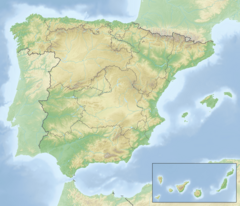San Fernando Naval Museum facts for kids
| Museo Naval de San Fernando | |
| Location | San Fernando, Spain |
|---|---|
| Coordinates | 36°28′02″N 6°11′37″W / 36.4672°N 6.1936°W |
| Website | www |
The San Fernando Naval Museum (known as Museo Naval de San Fernando in Spanish) is a cool place to learn about Spain's navy history. It's located in San Fernando, a city in the Province of Cádiz, Andalusia, Spain. The museum's main goal is to share the exciting story of the Spanish Armada and its presence in the area.
The idea for a naval museum in San Fernando first came up a long time ago, in 1792. A museum was actually started in 1843. However, the museum you can visit today officially opened its doors on March 27, 1992.
Contents
The idea for a special Naval Museum was first suggested by King Carlos IV and his Secretary of the Navy, Antonio Valdés y Fernández Bazán, back in 1792. They wanted a place to gather knowledge about the navy.
Even though the idea was old, the current museum didn't open until March 27, 1992. Just a couple of years later, on July 6, 1994, King Juan Carlos I and Queen Sofia of Spain made the first official royal visit.
What You Can See at the Museum
The museum has 21 different rooms, each telling a part of Spain's military history. Here are some of the highlights:
Starting Your Journey
The Foyer: A Grand Welcome
When you first enter, the Foyer shows you the original idea behind the museum. You'll see portraits of King Carlos III and Antonio Valdés y Fernández Bazán. These two important figures helped bring new ideas to the Spanish Navy.
Underwater Discoveries
This room is all about underwater archaeology, which is like being a detective under the sea! You can see objects that have been found in the water. These include old cannons, bullets, parts of ships, and ancient anchors from Phoenician and Roman times. There's even an old diving suit, showing how these underwater explorations began.
The Battle of Trafalgar
This small room tells the story of the famous Battle of Trafalgar. This big sea battle happened near Cape Trafalgar in 1805. You can see detailed models of two important ships from the battle: the English ship HMS Victory and the Spanish ship San Juan Nepomuceno.
Marine Infantry: Soldiers of the Sea
Here, you'll find items related to the Marine Infantry, who are soldiers trained to fight on land and sea. Look out for old uniforms, historical photographs, communication devices, and even a special recoilless cannon.
Folklore: Stories and Objects
In this area, you'll find some larger, interesting objects. One special item is a clock that used to belong to the church of the Arsenal de la Carraca. There's also an old carriage, nicknamed "La Manolita," which was once used by the Commander of the Marine Training Headquarters.
Manoeuvre: Ship Parts and Art
In the covered courtyard, you'll see big objects. A standout piece is the first figurehead from the training ship Juan Sebastián Elcano. A figurehead is a carved figure that used to be on the front of old sailing ships.
Grand Staircase and Dome
As you go up the spiral stairs, you'll notice beautiful 18th-century tiles from Delft, Holland. This town is famous as the birthplace of the painter Johannes Vermeer. At the top, you'll see a magnificent dome.
Flags and Important Papers
On the second floor, around a central area, you'll find many battle flags from Navy ships. There are also important documents from famous leaders like Niceto Alcalá Zamora, Francisco Franco, and Juan Carlos I.
Uniforms and Medals
This room displays a wide variety of historical uniforms, complete with their accessories and decorations. You can also see personal items belonging to important naval figures.
Ships, Weapons, and Technology
Juan Sebastián Elcano: A Famous Ship
This room is dedicated to both Juan Sebastián Elcano, the explorer, and the training ship of the Spanish Navy named after him. You can see maps showing all the training voyages the ship has made. There are also important historical books about its journeys.
Here, you can see different types of firearms, both portable and handheld. There are also portraits of important people in naval artillery, like José González Hontoria.
This room is all about the history of the Spanish Navy. A large display panel uses pictures and text to explain the most important events in the Navy's history in Spain.
Underwater Weapons: Torpedoes and Inventors
Discover examples of underwater weapons, including two torpedoes. You'll also learn about famous inventors like Narciso Monturiol and Isaac Peral, who created early submarines.
The Navy started using aircraft in the 20th century, and this room shows its growing importance. You'll see models of famous ships like the two Dédalos (seaplane carrier and aircraft carrier). Today, the aircraft carrier Príncipe de Asturias uses Harrier jets that can take off and land vertically. You can also see models of different helicopters used by the Navy.
Ship Models and Sailing Art
This room features amazing models of historical ships. One impressive model is an 18th-century frigate with 24 guns. There's also a beautiful collection of model sailing ships made from guaiacan wood.
This section explores the big changes in the Navy during the 20th century. You'll see naval models and parts of ships, like old compasses and other scientific tools used for sailing. A stunning watercolor painting by Aledo, called Galera Real del siglo XVI, is also on display.
See also
 In Spanish: Museo Naval de San Fernando para niños
In Spanish: Museo Naval de San Fernando para niños


